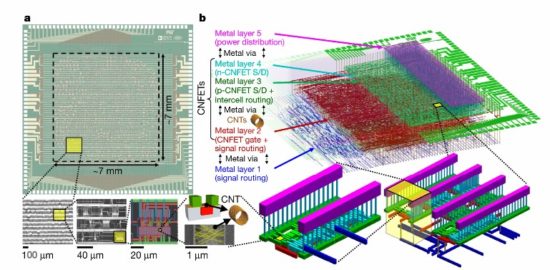September 2, 2019 – When Gordon Moore, a co-founder of Intel, and Director of Research and Development at Fairchild Semiconductor back in the 1960s first postulated the law associated with his name. He predicted that the number of components per integrated circuit would double every two years based on new manufacturing techniques and advances in photolithography and the use of silicon materials. This prophecy proved true at Intel where new microprocessors kept packing more transistors into chips amounting to billions in a single microprocessor.
The limits of silicon, thinness and heat tolerance, however, have put a crimp recently in Moore’s prediction (he only meant it to be reliable for a decade from the 1970s through to the 80s so he can be forgiven). But some Massachusetts Institute of Technology (MIT) researchers may yet revive the doubling prediction through the invention of a new microprocessor made from carbon nanotubes.
The microprocessor they have developed in the lab performs calculations faster and is up to ten times more energy-efficient. This means devices operating with a chip like this would draw far less energy from batteries extending operating life. The MIT crew have published their invention in an article appearing in the journal Nature.
They describe the microprocessor as a major paradigm shift for the industry once they get the bugs out of the manufacturing process. The chip is a 16-bit microprocessor that runs standard 32-bit instructions and contains over 14,000 metal-oxide-semiconductor carbon nanotube field-effect transistors. The MIT crew used standard design flow processes to fabricate the chip.
There is a bit of a problem still to be worked out. At nanoscales, carbon nanotubes tend to have imperfections that can botch the manufacturing process and reliability of the end product. The cause of the problem is in the nature of carbon nanotubes which have a tendency to bunch together. This crowding effectively knocks transistors out of action.
To overcome this tendency to the imperfect in the process, the researchers coated wafers in a polymer and washed them off in stages stripping out the clumped nanotubes and leaving the layer of working carbon-nanotube-based transistors working efficiently.
Note that a 14,000 transistor nanotube built microprocessor doesn’t come close to today silicon-based billion-plus transistor chips, which means for this laboratory-based invention to finally make it into commercial production, the developers will need to ramp up the number of transistors per wafer. The MIT team is in a race with IBM which is also developing carbon nanotube chips. It will be interesting to see if other labs and companies develop the technology creating another Moore’s Law arms race in the chip business.










